Bohan Yang
Leveraging CORAL-Correlation Consistency Network for Semi-Supervised Left Atrium MRI Segmentation
Oct 21, 2024



Abstract:Semi-supervised learning (SSL) has been widely used to learn from both a few labeled images and many unlabeled images to overcome the scarcity of labeled samples in medical image segmentation. Most current SSL-based segmentation methods use pixel values directly to identify similar features in labeled and unlabeled data. They usually fail to accurately capture the intricate attachment structures in the left atrium, such as the areas of inconsistent density or exhibit outward curvatures, adding to the complexity of the task. In this paper, we delve into this issue and introduce an effective solution, CORAL(Correlation-Aligned)-Correlation Consistency Network (CORN), to capture the global structure shape and local details of Left Atrium. Diverging from previous methods focused on each local pixel value, the CORAL-Correlation Consistency Module (CCM) in the CORN leverages second-order statistical information to capture global structural features by minimizing the distribution discrepancy between labeled and unlabeled samples in feature space. Yet, direct construction of features from unlabeled data frequently results in ``Sample Selection Bias'', leading to flawed supervision. We thus further propose the Dynamic Feature Pool (DFP) for the CCM, which utilizes a confidence-based filtering strategy to remove incorrectly selected features and regularize both teacher and student models by constraining the similarity matrix to be consistent. Extensive experiments on the Left Atrium dataset have shown that the proposed CORN outperforms previous state-of-the-art semi-supervised learning methods.
Modal-Graph 3D Shape Servoing of Deformable Objects with Raw Point Clouds
Apr 18, 2023Abstract:Deformable object manipulation (DOM) with point clouds has great potential as non-rigid 3D shapes can be measured without detecting and tracking image features. However, robotic shape control of deformable objects with point clouds is challenging due to: the unknown point-wise correspondences and the noisy partial observability of raw point clouds; the modeling difficulties of the relationship between point clouds and robot motions. To tackle these challenges, this paper introduces a novel modal-graph framework for the model-free shape servoing of deformable objects with raw point clouds. Unlike the existing works studying the object's geometry structure, our method builds a low-frequency deformation structure for the DOM system, which is robust to the measurement irregularities. The built modal representation and graph structure enable us to directly extract low-dimensional deformation features from raw point clouds. Such extraction requires no extra point processing of registrations, refinements, and occlusion removal. Moreover, to shape the object using the extracted features, we design an adaptive robust controller which is proved to be input-to-state stable (ISS) without offline learning or identifying both the physical and geometric object models. Extensive simulations and experiments are conducted to validate the effectiveness of our method for linear, planar, tubular, and solid objects under different settings.
EEG Machine Learning for Analysis of Mild Traumatic Brain Injury: A survey
Aug 10, 2022
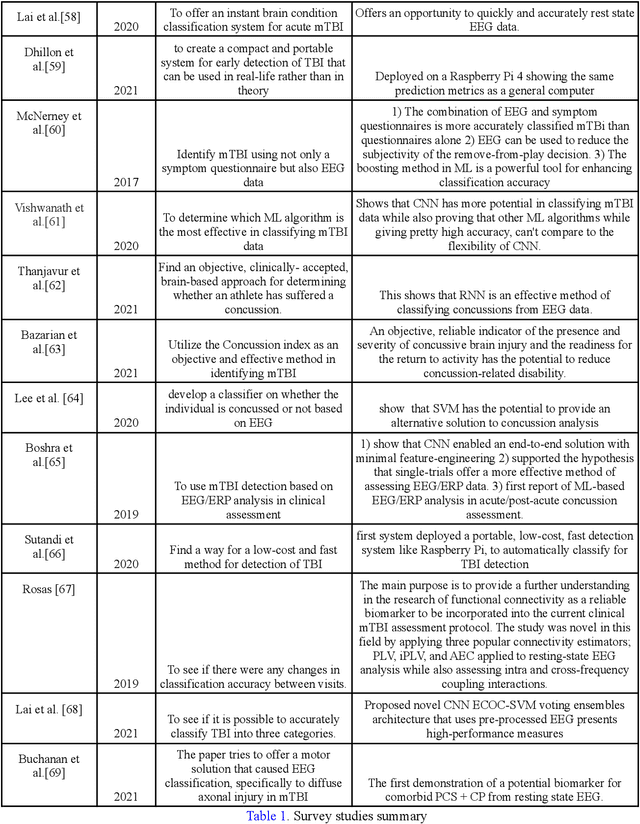


Abstract:Mild Traumatic Brain Injury (mTBI) is a common brain injury and affects a diverse group of people: soldiers, constructors, athletes, drivers, children, elders, and nearly everyone. Thus, having a well-established, fast, cheap, and accurate classification method is crucial for the well-being of people around the globe. Luckily, using Machine Learning (ML) on electroencephalography (EEG) data shows promising results. This survey analyzed the most cutting-edge articles from 2017 to the present. The articles were searched from the Google Scholar database and went through an elimination process based on our criteria. We reviewed, summarized, and compared the fourteen most cutting-edge machine learning research papers for predicting and classifying mTBI in terms of 1) EEG data types, 2) data preprocessing methods, 3) machine learning feature representations, 4) feature extraction methods, and 5) machine learning classifiers and predictions. The most common EEG data type was human resting-state EEG, with most studies using filters to clean the data. The power spectral, especially alpha and theta power, was the most prevalent feature. The other non-power spectral features, such as entropy, also show their great potential. The Fourier transform is the most common feature extraction method while using neural networks as automatic feature extraction generally returns a high accuracy result. Lastly, Support Vector Machine (SVM) was our survey's most common ML classifier due to its lower computational complexity and solid mathematical theoretical basis. The purpose of this study was to collect and explore a sparsely populated sector of ML, and we hope that our survey has shined some light on the inherent trends, advantages, disadvantages, and preferences of the current state of machine learning-based EEG analysis for mTBI.
Machine Learning-based EEG Applications and Markets
Aug 10, 2022



Abstract:This paper addresses both the various EEG applications and the current EEG market ecosystem propelled by machine learning. Increasingly available open medical and health datasets using EEG encourage data-driven research with a promise of improving neurology for patient care through knowledge discovery and machine learning data science algorithm development. This effort leads to various kinds of EEG developments and currently forms a new EEG market. This paper attempts to do a comprehensive survey on the EEG market and covers the six significant applications of EEG, including diagnosis/screening, drug development, neuromarketing, daily health, metaverse, and age/disability assistance. The highlight of this survey is on the compare and contrast between the research field and the business market. Our survey points out the current limitations of EEG and indicates the future direction of research and business opportunity for every EEG application listed above. Based on our survey, more research on machine learning-based EEG applications will lead to a more robust EEG-related market. More companies will use the research technology and apply it to real-life settings. As the EEG-related market grows, the EEG-related devices will collect more EEG data, and there will be more EEG data available for researchers to use in their study, coming back as a virtuous cycle. Our market analysis indicates that research related to the use of EEG data and machine learning in the six applications listed above points toward a clear trend in the growth and development of the EEG ecosystem and machine learning world.
Model-Free 3D Shape Control of Deformable Objects Using Novel Features Based on Modal Analysis
Jul 04, 2022



Abstract:Shape control of deformable objects is a challenging and important robotic problem. This paper proposes a model-free controller using novel 3D global deformation features based on modal analysis. Unlike most existing controllers using geometric features, our controller employs a physically-based deformation feature by decoupling 3D global deformation into low-frequency mode shapes. Although modal analysis is widely adopted in computer vision and simulation, it has not been used in robotic deformation control. We develop a new model-free framework for modal-based deformation control under robot manipulation. Physical interpretation of mode shapes enables us to formulate an analytical deformation Jacobian matrix mapping the robot manipulation onto changes of the modal features. In the Jacobian matrix, unknown geometry and physical properties of the object are treated as low-dimensional modal parameters which can be used to linearly parameterize the closed-loop system. Thus, an adaptive controller with proven stability can be designed to deform the object while online estimating the modal parameters. Simulations and experiments are conducted using linear, planar, and solid objects under different settings. The results not only confirm the superior performance of our controller but also demonstrate its advantages over the baseline method.
Stereo Dense Scene Reconstruction and Accurate Laparoscope Localization for Learning-Based Navigation in Robot-Assisted Surgery
Oct 08, 2021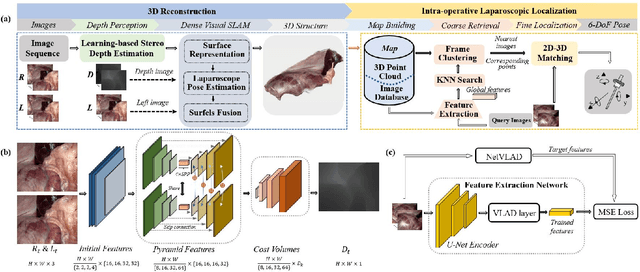
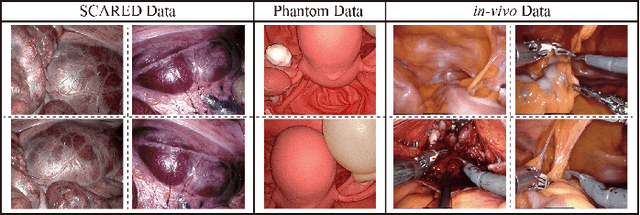
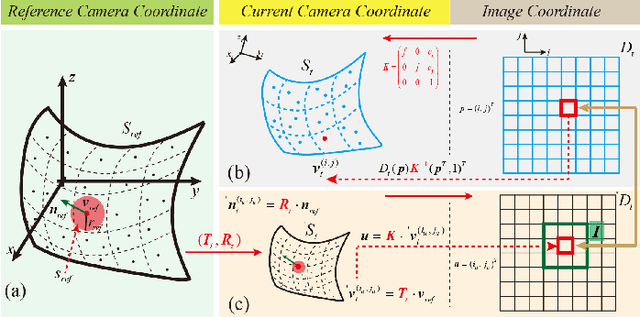
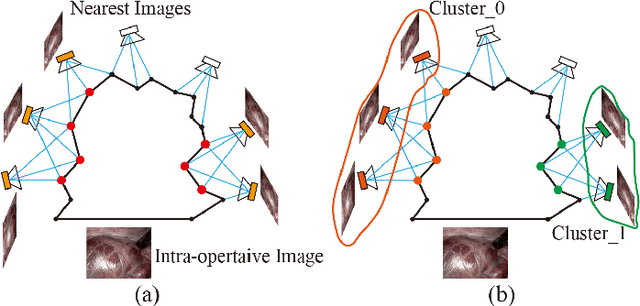
Abstract:The computation of anatomical information and laparoscope position is a fundamental block of robot-assisted surgical navigation in Minimally Invasive Surgery (MIS). Recovering a dense 3D structure of surgical scene using visual cues remains a challenge, and the online laparoscopic tracking mostly relies on external sensors, which increases system complexity. In this paper, we propose a learning-driven framework, in which an image-guided laparoscopic localization with 3D reconstructions of complex anatomical structures is hereby achieved. To reconstruct the 3D structure of the whole surgical environment, we first fine-tune a learning-based stereoscopic depth perception method, which is robust to the texture-less and variant soft tissues, for depth estimation. Then, we develop a dense visual reconstruction algorithm to represent the scene by surfels, estimate the laparoscope pose and fuse the depth data into a unified reference coordinate for tissue reconstruction. To estimate poses of new laparoscope views, we realize a coarse-to-fine localization method, which incorporates our reconstructed 3D model. We evaluate the reconstruction method and the localization module on three datasets, namely, the stereo correspondence and reconstruction of endoscopic data (SCARED), the ex-vivo phantom and tissue data collected with Universal Robot (UR) and Karl Storz Laparoscope, and the in-vivo DaVinci robotic surgery dataset. Extensive experiments have been conducted to prove the superior performance of our method in 3D anatomy reconstruction and laparoscopic localization, which demonstrates its potential implementation to surgical navigation system.
 Add to Chrome
Add to Chrome Add to Firefox
Add to Firefox Add to Edge
Add to Edge